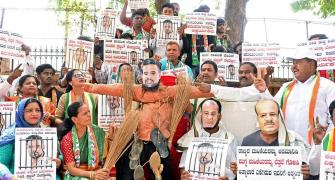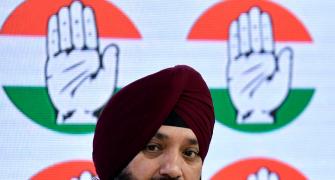As many Hindu parents in America and Canada know too well, you just cannot be prepared for all the questions your child has to face in the school. Questions like: Why do Hindus worship the cow? Are Hindu Gods always married to many women? Why do Hindus worship idols?
And then there are endless questions about what Americans call the dot. Not to forget questions about the Hindu pantheon of gods.
The parents' answers and explanations are often not satisfactory to the children -- or, for that matter, to the parents themselves. Often the parents ask someone in the community, who has commanding knowledge of Hinduism, for answers or seek the help of a Hindu scholar, or in libraries.
Now, parents and children can turn to What is Hinduism? -- a landmark book with over 400 large pages and nearly 1,000 illustrations that answers the above questions, and many more, with brevity and clarity.
One of the book's important achievements is in creating context that explains otherwise inexplicable Hindu practices.
For instance, it connects social practices like untouchability to segregation practiced in America a few decades ago, and to the fact that there are millions in America including African Americans and Hispanics who face continual discrimination in residential areas, schools, at workplaces and in places of worship. These are the true 'untouchables,' the book writes.
After telling the readers that it is illegal in India to discriminate against, abuse or insult anyone on the basis of caste, the book looks at modern America, adding that there is a class system in the United States that is very bad.
'US cities are more racially segregated than before the 1950s Civil Rights Movement because of white flight to the suburbs,' the book notes. 'Black Americans receive harsher sentences than white Americans for the same crime.' It goes on to write a few lines on the plight of Native Americans too.
'This kind of response -- we can call it the you're one, too defense -- doesn't mean Hindus should not work much harder to end caste discrimination,' the book warns. But it reminds others that 'no country in the world is yet free from racial discrimination.'
Among the many subjects the book addresses is the theme of holy cows. 'Hindus don't worship cows,' the book, compiled from articles and information in Hinduism Today magazine, notes. 'We respect, honour and adore the cow. By honouring this gentle animal, who gives more than she takes, we honour all creatures.'
The chapter on the cow also touches upon vegetarianism. While it explains the rationale behind a vegetarian diet, it also notes that while many Hindus are not vegetarians, 'most respect the still widely held code of abstaining from eating beef.'
Are Hindus forbidden to eat meat, is another question immigrant Indians often face. The book does not point out that in most regions of India the majority of Hindus eat meat and fish, and it does not reveal that Bengali Brahmins eat fish religiously, and that Swami Vivekananda continued eating fish even after he had become a monk or even that the Buddhist spiritual leader the Dalai Lama is a non-vegetarian.
However, the book notes: 'Hindus teach vegetarianism as a way to live with a minimum hurt to other beings. But in today's world not all Hindus are vegetarians. Of course, there are good Hindus who eat meat, and there are not-so-good Hindus who are vegetarians.'
The book offers a wealth of information on various aspects of Hinduism, from the devotional to cultural to epicurean. Published by the Himalayan Academy in Kauai, Hawaii, the book is based on hundreds of articles published in the magazine over the past 25 years.
The academy, which also produces the erudite and popular Hinduism Today magazine, is part of the Hindu monastery founded by Sivaya Subramuniyaswami, popularly known as Gurudeva, more than five decades ago. Though the Kauai monastery is a Saivite institution, the book deals with various Hindu traditions and offers the kind of insights not often found in other books of its kind.
In one of the important chapters in the book, Comparing the Four Major Denominations, Saivisim, Shaktism. Vaishnavism, and Smartism, the authors assert there are more similarities, including the importance of temple worship and the concept of liberation of the soul from rebirth, than differences between the four denominations.
But the book also explains some of the key differences between them. Saivite Hindus do not believe in earthly incarnations of the Supreme Being; the Divine Mother incarnate in this world is the belief of Shatki followers. Vaishnavism believes that Vishnu has ten or more incarnations. And the Smarta followers believe all deities assume earthly incarnations.
The subject of idol worship is a big issue in America, where many fundamentalist Christians rebuke Hindus calling them idol worshippers. In school text books and in social science classes, Hindu children are often faced with opprobrium on such lines.
'Hindus do not worship stone or metal 'idol' as God,' the editors of What is Hinduism? note in the chapter titled Ten Questions People Ask About Hinduism. 'We worship God through the image. We invoke the presence of God from the higher, unseen worlds, into the images so that we can commune with Him and receive His blessings.'
One of the plus points for the book is its humour. 'Hindus are not idle worshippers,' the book continues. 'I have never seen a Hindu worship in a lazy or idle way.'
As for the question about 'graven images,' the book says all religions 'have their symbols of holiness through which the sacred flows into the mundane': The Christian cross or statues of Mary, the holy Kaaba in Mecca, the Sikh Adi Granth enshrined in the Golden Temple in Amritsar.
'The Hindu can see God in stone and water, fire, air and ether, and inside his own soul,' the book says. 'Indeed, there are Hindu temples which have in the sanctum sanctorum no image at all but a yantra, a symbolic or mystic diagram. However, the sight of the image enhances the devotee's worship.'
And then there are the questions about sex, marriage and the Gods. There is a Hinduism of the Puranas which is filled with stories about gods and goddesses, the book says. But there is also a Hinduism of higher philosophies in which gods are neither male or female. 'In fact, attaining to that godly level of being is one of the mystical goals of yoga,' the book asserts. 'Hindus know that the Gods do not marry, that they are complete within themselves.'
The editors of What is Hinduism? say that some people in other faiths criticise the Hindu religion as a sort of comic book religion. 'We should not be part of perpetuating that image by passing on such misconceptions as the marriage of the Gods,' the editors note.
 Some modern swamis urge devotees not to pay attention to Puranic stories about the Gods, saying that they have no relationship with the world today, the book argues. These swamis do not want children to read those stories because children may not be able to understand them in proper context. 'Instead, they (the swamis) encourage followers to deepen themselves with the higher philosophies of the Vedic Upanishads and the realisation of the Hindu seers.'
Some modern swamis urge devotees not to pay attention to Puranic stories about the Gods, saying that they have no relationship with the world today, the book argues. These swamis do not want children to read those stories because children may not be able to understand them in proper context. 'Instead, they (the swamis) encourage followers to deepen themselves with the higher philosophies of the Vedic Upanishads and the realisation of the Hindu seers.'
One of the highlights of the book is the reproduction of Swami Vivekananda's Song of the Sanyasin, which is spread across two pages, along with the picture of Vivekananda and the image of Thousand Island Park, New York, where the visiting monk composed the song.
'There is but One: the Free, the Knower, Self.
Without a name, without a form or stain.
In Him is maya, dreaming all this dream..
The Witness, He appears as nature, soul.
Know thou art That, sannyasin bold! Say
'Om Tat Sat, Om.'







